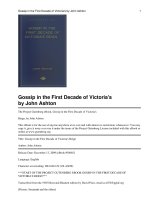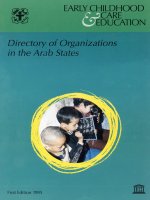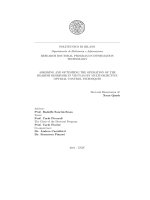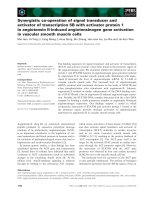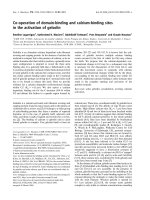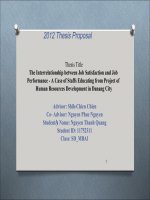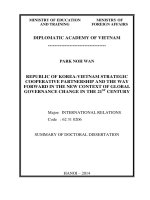operation of american non-governmental organizations in the first decade of the twenty-first century in danang
Bạn đang xem bản rút gọn của tài liệu. Xem và tải ngay bản đầy đủ của tài liệu tại đây (560.48 KB, 18 trang )
Operation of American Non-governmental
Organizations in the first decade of the
twenty-first century in Danang
Lê Thị Phương Loan
Trường Đại học Khoa học Xã hội và Nhân văn
Luận văn ThS ngành: Quan hệ quốc tế; Mã số: 60 31 02 06
Người hướng dẫn: PGS.TS. Hoàng Khắc Nam
Năm bảo vệ: 2013
Keywords. Quan hệ quốc tế; Tổ chức phi chính phủ; Đà Nẵng; Thế kỷ 21; Hoa Kỳ
Content
1
TABLE OF CONTENTS
TITLE PAGE i
COPYRIGHT PAGE iii
ACKNOWLEDGEMENTS iv
ABSTRACT v
TABLE OF CONTENTS 1
LIST OF ACRONYMS 3
LIST OF FIGURES AND TABLES 5
INTRODUCTION 6
Rationale 6
Subjective of Study 7
Aims and Objectives of Study 8
Research Questions 8
Scope of Study 9
Research Methods 9
Organization of Study 9
CHAPTER 1: THEORETICAL AND PRACTICAL BACKGROUND 11
1.1. Overview of Non-governmental Organizations 11
1.1.1. Definition of Non-governmental Organizations 11
1.1.2. Development and Evolution Stages of NGOs 15
1.1.3. Functions and Classification of NGOs 21
1.2. Overview of operation of American NGOs in Vietnam 25
1.2.1. Overview of American NGOs 25
1.2.1. Views of Vietnam toward International and American NGOs operating in
Vietnam 30
1.2.3. Processes of Development and Fields of Operation of American NGOs in
Vietnam 33
CHAPTER 2: CURRENT SITUATION OF AMERICAN NON-GOVERNMENTAL
ORGANIZATIONS IN DANANG CITY 37
2.1. Views of Danang Government toward Processes of Development of American
NGOs in the city 38
2
2.2. American NGOs operating in the sector of Hunger eradication and Poverty
alleviation 41
2.2.1. Current Situation 41
2.2.2. The Cooperation of Local Authorities and Achievements 45
2.3. American NGOs operations in the Education sector 46
2.3.1. Current situation 46
2.3.2. The Cooperation of Local Authorities and Achievements 51
2.4. American NGOs operations in the Healthcare sector 52
2.4.1. Current situation 52
2.4.2. The Cooperation of Local Authorities and Achievements 60
2.5. American NGOs operations in the Childcare sector 61
2.5.1. Current situation 61
2.5.2. The Cooperation of Local Authorities and Achievements 66
2.6. American NGOs operations in other Humanitarian activities 67
2.6.1. Current situation 67
2.6.2. The cooperation of local authorities and Achievements 72
CHAPTER 3: AN ASSESSMENT OF IMPACTS AND POTENTIALS OF AMERICAN
NGOs’ OPERATION IN DANANG 75
3.1. Impacts of American NGOs’ Activities in Danang 76
3.1.1. Positive Impacts 76
3.1.2. Negative impacts 79
3.2. Development Potentials of American NGOs’ Activities in Danang 82
3.2.1. Advantages 82
3.2.2. Challenges 82
3.3. Recommendations to the operation of American NGOs in Danang 84
3.3.1 Recommendations to American NGOs 84
3.3.2 Recommendations to City Authorities and Local Governments 85
CONCLUSION 87
REFERENCES 92
APPENDIX 102
6
INTRODUCTION
Rationale
Globalization in the twenty-first century has paved the way for non-
governmental organizations (NGOs) to thrive and achieve significant
recognition worldwide. International NGOs have been accredited for their
endless efforts since the early 1990s when NGOs’ operation mostly focused on
providing technical support and disaster relief to developing countries. It is,
thus, believed that international NGOs have made positive contributions to
sustainable development of developing countries, especially to the process of
improving and promoting the people’s standard of living. In the last decades,
there has been a sharp increase in the quantity and operation scale of NGOs in
international relations, i.e. from 1,250 in 1980 to 45,000 in 2000. In addition,
NGOs have become governments’ crucial partners in facilitating community
development all over the world. As a consequence, the study of NGOs’
operation has attracted deeper attention in more diverse fields.
International NGOs first came to Vietnam long ago. Initially, they worked
mainly in the South of Vietnam. Since 1975, yet, international NGOs have
considerably assisted Vietnam in reconstructing the nation, gradually promoting
economic growth, and improving people’s living standard. The number of
international NGOs, hence, steadily increased in accordance with the country’s
development, from 200 to 600 in 1990 and 2006 respectively. Impressively, at
the end of the first decade of this century, this figure was already 800. The fields
of operation also varied ranging from economic development, hunger alleviation
and poverty reduction, environmental protection, emergency relief, social issues
settlement to capacity building for Vietnamese partners. Likewise, the total
7
finance assistance in 2009 was nearly 270 million USD, which was nearly
seventeen times that of the early 1990s.
Danang, the fourth largest city in Vietnam, is the biggest cultural,
economic, educational, scientific and technological center of the Central
Highlands. Since 1997, the city has gained remarkable growth in almost fields
from education, science, economics, to tourism. This resulted from appropriate
development policies, good management of the city government, and support of
its citizens, as well as foreign and domestic cooperates, enterprises and NGOs.
International NGOs in Danang have supported the city greatly in diverse forms
of aid programs: from human resource training, to technological supply or
humanitarian relief for the poor, disaster and war calamities. From 1997 to 2007,
the total amount of financial assistance to Danang reached 1,025 billion VND.
International NGOs have shifted their interest to bigger scope, and more
sustainable projects, which are skewed to be in line with the development pace
and demand of such a “young” city. Nonetheless, there have been a number of
downsides in NGOs’ projects and lack of immediate responses of the city or
local government in which the projects are implemented. Currently, American
NGOs account for 50% out of 110 foreign NGOs having partnerships with
Danang city. On that account, to have a better understanding of the current
status, fields of operation and impacts of American NGOs, particularly in
Danang city, I have chosen “Operation of American NGOs in the first decade of
the twenty first century in Danang” as a Master’s thesis in the field of
International Relations.
Subjective of Study
From the above mentioned reasons, this study is intended to focus on
activities of only international American NGOs within the city of Danang from
8
2001 to 2011 in five fields, i.e. hunger eradication and poverty alleviation;
education; healthcare; childcare; and other humanitarian activities.
Aims and Objectives of Study
This study is aimed at conceptualizing international non-governmental
organizations in terms of definition, classification, functions, and roles in
international relations.
In addition, this study is to discuss operation of international American
NGOs in Danang and their impacts of projects implemented in the early years of
the twenty-first century.
Also, this study is about to analyze challenges and advantages in the
potentials of American NGOs in Danang.
Accordingly, some suggestions and recommendations will be proposed to
improve the effectiveness of American NGOs’ activities in Danang in the near
future.
Research Questions
Based on the above aims and objectives, this study will be the answers to
the following research questions:
- What is the current status of operation of American NGOs in Danang?
- What are their major fields of operation?
- What are positive and negative impacts of American NGOs’ operation
within the city?
- What are challenges and advantages to promote American NGOs’
activities in the city?
9
Scope of Study
The scope of the study is American NGOs’ operation in Danang city in
the first decade of the twenty first century, particularly for a period of ten years
from 2001 to 2011 in the fields namely: hunger eradication and poverty
alleviation; education; healthcare; childcare; and other humanitarian activities,
i.e. supporting the disabled, tackling issues of dioxin contamination, or early
warning and prevention of natural disasters, etc.
The above fields are selected to study for they are matters of concern of
American NGOs in Danang. These issues have also been included in the five-
year socio-economic development plans of Danang city since 1997. Thus, the
study of the five above fields is expected to make a comprehensive evaluation of
operation of American NGOs in the city for the first ten years of the twenty-first
century.
Research Methods
Based on the above study aims and research questions, in this study, both
qualitative and quantitative approaches are employed along with the following
methodologies of international relations: meta-analysis: collecting information
from the public previous research; elite interview of American NGOs’
coordinators, founders, directors in Danang; statistical analysis; observation;
level of analysis; foreign policy analysis; analyzing roles and functions of
international NGOs from neo-liberalism perspective.
Organization of Study
This study will be structured in three major chapters:
Chapter 1: THEORETICAL BACKGROUND
10
This chapter presents the previous researches with different points of view
about non-governmental organizations since the term came into being.
Also, theoretical background related to the study will be presented clearly
in this chapter.
Chapter 2: CURRENT STATUS OF AMERICAN NGOs’ IN DANANG CITY
This is the main part of the whole study in which the current status of
American NGOs’ operation in Danang from 2001 to 2011 will be
analyzed from collected data.
Chapter 3: AN ASSESSMENT OF IMPACTS AND POTENTIALS OF
AMERICAN NGOS’ OPERATION IN DANANG
In this chapter, some impacts, both positive and negative ones, on certain
fields of operation of American NGOs’ will be discussed. Additionally,
challenges and potentials of those NGOs to operate in Danang are to be
looked at carefully. Finally, I will deliver some recommendations to the
operation of American NGOs in Danang city.
92
REFERENCES
A. Vietnamese Resource
1. Nguyễn Mại (chủ biên) (2004), Quan hệ Việt Nam – Hoa Kỳ: Hướng về phía
trước, Nxb. Tri thức.
2. Hoàng Khắc Nam (2008), Tổ chức quốc tế và chủ thể phi quốc gia trong bối
cảnh quốc tế mới, Tạp chí Những vấn đề Kinh tế và Chính trị thế giới, số 8
(148), tr. 10-1.
3. Nguyễn Thái Yên Hương, Lê Đình Tĩnh (2004), Các tổ chức phi chính phủ
trong hoạt động đối ngoại của Mỹ, Đề tài nghiên cứu khoa học cấp Viện,
Học viện Quan hệ quốc tế.
4. Sở Ngoại vụ thành phố Đà Nẵng (2008), Báo cáo mười năm về công tác viện
trợ phi chính phủ nước ngoài trên địa bàn thành phố Đà Nẵng.
5. Sở Ngoại vụ thành phố Đà Nẵng (2009), Báo cáo công tác viện trợ năm
2009.
6. Sở Ngoại vụ thành phố Đà Nẵng (2009), Các dự án lớn đã và đang triển khai
từ 2006-2009.
7. Sở Ngoại vụ thành phố Đà Nẵng (2009), Báo cáo số liệu viện trợ của các tổ
chức phi chính phủ nước ngoài năm 2009, từ 15/11/2008 – 30/11/2009.
8. Sở Ngoại vụ thành phố Đà Nẵng (2010), Báo cáo số liệu viện trợ của các tổ
chức phi chính phủ nước ngoài năm 2010, từ 30/11/2009 – 30/11/2010.
9. Sở Ngoại vụ thành phố Đà Nẵng (2011), Báo cáo số liệu viện trợ của các tổ
chức phi chính phủ nước ngoài năm 2011, từ 30/11/2010 – 30/11/2011.
10. Sở Ngoại vụ thành phố Đà Nẵng (2009), Danh sách NGO khu vực châu Mỹ
có quan hệ với thành phố Đà Nẵng.
11. Sở Ngoại vụ thành phố Đà Nẵng (2010), Danh sách NGO có văn phòng và
địa chỉ liên hệ tại thành phố Đà Nẵng.
93
12. Ban chỉ đạo quốc gia thực hiện chiến lược toàn diện về tăng trưởng và xóa
đói giảm nghèo (CPRGS), Tổ công tác liên ngành CPRGS (2005), Việt Nam
– Tăng trưởng và giảm nghèo, báo cáo thường niên 2004-2005.
13. Trung tâm Dữ liệu các Tổ chức Phi Chính phủ (VUFO - NGO Resource
Centre) (2003), Danh tập các tổ chức phi chính phủ nước ngoài hoạt động
tại Việt Nam 2003-2004, NXB Chính trị quốc gia.
14. Trung tâm Dữ liệu các Tổ chức Phi Chính phủ (VUFO - NGO Resource
Centre) (2009), Danh tập các tổ chức phi chính phủ nước ngoài hoạt động
tại Việt Nam 2008-2009, NXB Chính trị quốc gia.
15. Trung tâm Dữ liệu các Tổ chức Phi Chính phủ (VUFO - NGO Resource
Centre) (2010), Báo cáo của các Tổ chức Phi Chính Phủ Quốc tế về Quan
Hệ Đối tác vì sự Phát Triển năm 2010, bản điện tử tại:
16. Trung tâm Dữ liệu các Tổ chức Phi Chính phủ (VUFO - NGO Resource
Centre) (2005), Báo cáo của các tổ chức phi chính phủ quốc tế tại Hội nghị
tư vấn các nhà tài trợ cho Việt Nam 6-7, tháng 12 năm 2005
B. English Resource
17. Anheier, H. K. and Seibel, W. (1990), The Third Sector:
Comparative Studies of Nonprofit Organizations, Berlin/New York,
Walter de Gruyter, pg.361-376.
18. Banks, N. and Hulme, D. (2012), The role of NGOs and Civil Society in
development and poverty reduction, Brooks World Poverty Institute
working paper 171, pg.6.
19. Bebbington, A. J. (2005), Donor-NGO relations and representations of
livelihood in nongovernmental aid chains, World Development 33(6):
pg.937-950.
94
20. Blankenberg, F. (1995), Methods of Impact Assessment Research
Programme, Resource Pack and Discussion. The Hague: Oxfam UK/I and
Novib.
21. Cantwell, N. (1990), How NGOs contributed to drafting the Convention on
the Rights of the Child. Paper presented at the Symposium on The
Contribution of NGOs to the Formulation and Promotion of International
Human Rights Law, May 4, 1990, Palais des Nations, Geneva.
22. Cook, H. (1996), Amnesty International at the United Nations. In Willetts,
P. (ed.), The Conscience of the Wold: The Influence of Non-Governmental
Organizations in the UN System, Hurst, London, pg.181-213.
23. Dichter, T.W. (1997), “Appeasing the Gods of Sustainability: The Future of
International NGOs in Microfinance.” in NGOs, States and Donors: Too
Close for Comfort (D. Hulme and M. Edwards, eds), pg.128–139. New
York: St. Martin’s Press.
24. Etzioni, A. (1973), The Third Sector and Domestic Missions, Public
Administration Review, Vol. 33, No. 4, pg.314-323.
25. Fadzel, A. (2004), International conflicts and the roles of NGOs, working
paper, The University of Queensland - T.C. Beirne School of Law, available
at SSRN: or
26. Feld, Werner J., and Jordan, R. S., with Hurwitz, L. (1994), International
organizations: a comparative approach, third edition, Praeger.
27. Fowler, A. (2000), NGO futures: beyond aid: NGO values and the fourth
position, Third World Quarterly 21(4): pg.589-603.
28. Jordan, Robert S., (2001) International organizations: A comparative
approach to the management of cooperation, 4
th
edition, Praeger Publisher.
95
29. Hulme, D. and Edwards, M. (1995), Non-Governmental Organizations
Performance and Accountability Beyond The Magic Bullet. London:
Earthscan, pg.259.
30. Hulme, D. and Edwards, M. (1997), NGOs, States and Donors: Too Close
for Comfort?, Macmillan Press Ltd.
31. Howell, J. and Pearce, J. (2000), (David Lewis and Tina Wallace, Editors),
New Roles and Relevance; Development NGOs and the Challenge of
Change, Kumarian Press, pg.83.
32. Holloway, R. (1998), Establishing and Running an Advocacy NGO,
retrieved 14/11/2012 from:
33. Keck, M. E., and Sikkink, K. (1998), Activists Beyond Borders, Cornell
University Press, Cornell.
34. Kilby, P. (2006), Accountability for empowerment: dilemmas facing non-
governmental organizations, World Development 34(6): pg.951-963.
35. Kim H. (2000), Discuss the impact of non-governmental organizations
(NGOs) and their limits and opportunities in relation to social development
and civil society, making particular reference to examples from a selected
country or countries. Essay for Issues in Social Policy Analysis, Module
SLSP 5112, retrieved 9/2/2012 from:
/>f
36. Korten, D. C. (1990), Getting to the 21
st
Century: Voluntary Action and the
Global Agenda, West Hartford (CT), Kumarian Press.
37. Kruseet, S. E., Kylonnen, T. Ojanpera, S. Riddell, R. and Vieljus, J-L.
(1997), Searching for Impact and Methods NGO Evaluation Synthesis
Study. Finland: Finish Ministry of Foreign Affairs, (A Report Prepared for
The OECD/DAC Expert Group on Evaluation), pg.117.
96
38. Jayawickrama, S. and McCullagh, N. (2009), What Makes International
NGOs Distinctive? Contributions, Characteristics and Challenges, Hauser
Center for Nonprofit Organizations, Harvard University, Cambridge.
39. Lewis, D., and Kanji, N. (2009), Non-Governmental Organizations and
Development, Abingdon, UK: Routledge.
40. Lovrekovic, M. (2010), Assessment of International Development NGO
Activities in Vietnam, retrieved 14 November 2012 from:
/>onal%20Development%20NGO%20Activities%20in%20Veitnam.pdf/at_do
wnload/file
41. Marr, D. (1994), The Vietnam Communist Party and Civil Society, paper
presented at the ANU Vietnam Update 1994 Conference, Canberra.
42. Martens, K. (2002), Mission impossible? Defining Non-governmental
organizations, Voluntas: International Journal of Voluntary and Nonprofit
Organizations, Vol. 13, No. 3, pg.271-285.
43. McKelvey, B. (1982): Organizational Systematics. Taxonomy, Evolution,
Classification, Berkeley (CA): University of California Press
44. Michael, S. (2002), The role of NGOs in Human Security, working paper,
Hauser Center for Nonprofit Organizations, working paper No. 12.
45. OECD/DAC. (1997), Evaluation of programs promoting participatory
development and good governance. Paris: Organization for Economic Co-
operation and Development / Development Assistance Committee. –
retrieved 9/2/2012 from:
/>9e47b22ac1256c6f0060d02b?OpenDocument#sthash.gq1UtdnL.dpuf
46. Princen, T., and Finger, M. (1994) (eds.), Environmental NGOs in World
Politics. Linking the Local and the Global, Routledge, London.
97
47. Riddell, R. and Robinson, M. (1992), The impact of NGO poverty
alleviation projects: Results of the case study evaluations, Working paper
68, Overseas Development Institute, Regent’s College, London.
48. Robbins, R. (2002), Global Problems and the Culture of Capitalism, Allyn
and Bacon, Second Edition, pg.129.
49. Schoener, W. (1997), Non-governmental organizations and global activism:
Legal and informal approaches. Global Legal Studies Journal 4: pg.537-569
50. Shelton, D. (1994), The participation of nongovernmental organizations in
International Proceedings. American Journal of International Law 88(4):
pg.611-642.
51. Sinh, B. T., (2001), Civil Society and NGOs in Vietnam: Some Initial
Thoughts on Developments and Obstacles. Paper presented at the Meeting
with the Delegation of the Swedish Parliamentary Commission on Swedish
Policy for Global Development to Vietnam 26/2-3/3/2002, at Horison Hotel
March 2, 2001.
52. Smillie, I. and Helmich, H. (1993), Non-governmental Organizations and
Governments: Stakeholders for development, Centre of the Organization for
Economic Co-operation and Development (Paris and Washington, D.C.)
53. The Vietnam Committee for Foreign NGO affairs, Report on cooperation
between Vietnam and INGOs over the last 10 years 1993-2003, pg.8.
54. Willetts, P. (ed.) (1982), Pressure Groups in the Global System, Frances
Pinter, London.
55. Willetts, P. (2002), What is a Non-Governmental Organization?, City
University, London, UK, in UNESCO Encyclopedia of Life Support
Systems, Section 1: Institutional and Infrastructure Resource Issues, Article
1.44.3.7: Non-Governmental Organizations, retrieved 9/2/2012 from:
98
56. Sama, T. B. Conceptualizing Non-Governmental Organizations: Still
Searching For a Theory, retrieved 9/2/2012 from:
www.egpa2009.com/documents/psg8/Sama.pdf
57. Yamamoto, T., (1999) Corporate-NGO Partnership: Learning from Case
Studies, in Yamamoto, T., and Gould K., (1999), Corporate-NGO
Partnership in Asia-Pacific, ed., Ashizawa, Japan.
58. European Commission, Commission Discussion Paper: “The Commission
and Non-Governmental Organizations: Building a stronger partnership”
presented by President PRODI and Vice-President KINNOCK, retrieved
9/2/2012 from:
59. White, L. C. (1933), The Structure of Private International Organizations:
Their Purposes, Methods, and Accomplishments, Rutgers University Press,
New Brunswick, N.J.
60. Vietnam Committee for Foreign NGO affairs, Report on cooperation
between Vietnam and INGOs over the last 10 years 1993-2003.
C. Internet Resource
61. Asia Catalyst short report, Restrictions on AIDS NGOs in Asia, 1/2009.
www.asiacatalyst.org/news/restrictionsAIDSngos1209.pdf
62. Conference report, (2008), American support for education in Vietnam: a
brainstorming conference for American stakeholders, convened and hosted
by Ambassador Michael W. Michalak, Hanoi.
63. Clinton, H. R. (2010) Civil Society: Supporting Democracy in the 21st
Century, />democracy-in-the-21st-century-2/
99
64. Fact Sheet: Non-Governmental Organizations (NGOs) in the United States:
65. Gamboni, J. (2006), Non Governmental Organization, Master thesis,
retrieved on 14 February 2012 from:
66. Klein, N. Bush to NGOs: Watch your mouths, The Globe and Mail, June
20, 2003—Page A15,
67. International studies review, 2008, Help versus Harm: The Impact of NGO
Interventions, pg.286-289,
/>3_1007909.asp
68. Roles of NGOs in preventing ethnic conflict, 1998,
69. Bộ Ngoại giao Việt Nam, Các tổ chức quốc tế,
70. VUFO - NGO resource center,
71. Sở ngoại vụ thành phố Đà Nẵng, Viện trợ phi chính phủ:
72. Shar, A. (2005), NGOs on Development Issues, available at:
/>development-issues
73. United Nations, Chapter 27, Agenda 2, Strengthening The Role of Non-
governmental Organizations: Partners For Sustainable Development,
74. The World Bank, Poverty Reduction in Vietnam: Remarkable Progress,
Emerging Challenge,
/>in-vietnam-remarkable-progress-emerging-challenges
100
75. NGOs,
76. United Nations, Basic Statistics about Vietnam,
77. />development-issues
78. Rise and role of NGOs in sustainable development,
79. />to-chuc-phi-chinh-phu
80.
81. NGO Global Network,
82.
83. Introduction to NGOs, printed in A guide to NGOs for the Military,
Introduction-to-NGOs.pdf
84. -
uim.org/site/modules/mastop_publish/files/files_4afdb230d9647.pdf
85. />non-profit-organizations/
86. />organizations-NGOs-in-Vietnam.html
87. www.ngocentre.org.vn/webfm_send/1265
88. />to-vietnam/#.UbQA7NjAGyQ
89.
90. />VN/News/thongtintonghop/kinhte/2013/11/32367.aspx
101
91. />px
92.
93. />nang.aspx
94. />goc_nhin_truyen_thong
95. />ngo/759-danh-sach-ngos
96.
